The Inventory Tag Market is estimated to be valued at USD 6.0 billion in 2025 and is projected to reach USD 9.3 billion by 2035, registering a compound annual growth rate (CAGR) of 4.6% over the forecast period.
The inventory tag market is experiencing robust growth driven by rising demand for efficient inventory management systems and enhanced supply chain visibility. The current market environment reflects widespread digitalization across logistics, retail, and manufacturing sectors. Growing emphasis on automation, traceability, and real-time monitoring is accelerating the adoption of advanced tagging technologies.
Regulatory focus on product authentication and compliance is reinforcing the need for reliable tagging solutions. The future outlook remains optimistic as companies continue to invest in data-driven inventory control systems that reduce losses and optimize warehouse efficiency. Expansion of e-commerce, omnichannel retailing, and just-in-time manufacturing models are creating sustained opportunities for market participants.
Growth rationale is supported by continuous technological innovation, cost-effective tag production, and expanding applications across industrial and commercial domains Strategic integration of smart tags with enterprise resource planning systems is expected to strengthen overall inventory accuracy and operational transparency, positioning the market for stable and long-term expansion.
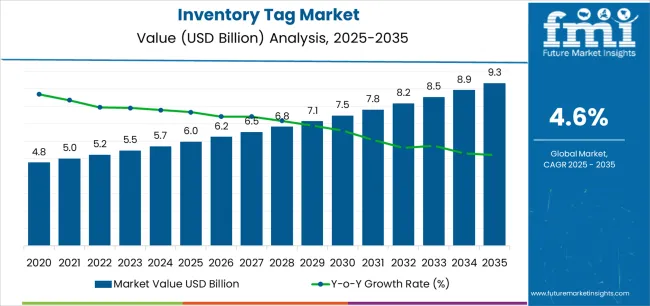
| Metric | Value |
|---|---|
| Inventory Tag Market Estimated Value in (2025 E) | USD 6.0 billion |
| Inventory Tag Market Forecast Value in (2035 F) | USD 9.3 billion |
| Forecast CAGR (2025 to 2035) | 4.6% |
The market is segmented by Technology, Materials, and End User and region. By Technology, the market is divided into RFID, Barcodes, and QR codes. In terms of Materials, the market is classified into Plastic, Metal, and Paper. Based on End User, the market is segmented into Retail, Industrial, Logistics, and Other. Regionally, the market is classified into North America, Latin America, Western Europe, Eastern Europe, Balkan & Baltic Countries, Russia & Belarus, Central Asia, East Asia, South Asia & Pacific, and the Middle East & Africa.
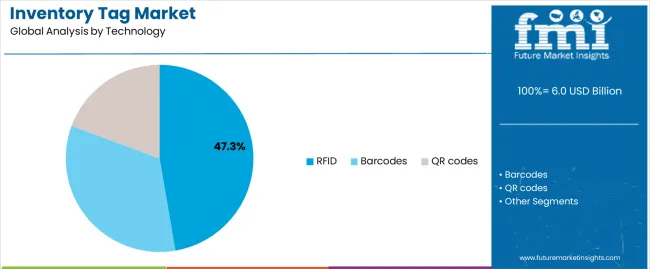
The RFID segment, accounting for 47.30% of the technology category, has established dominance due to its superior data storage capacity, rapid scanning capability, and ability to function without direct line-of-sight. Adoption has been driven by increasing automation in warehouses and retail environments where real-time tracking is critical.
The segment’s efficiency in reducing manual errors and improving asset traceability has reinforced its preference over traditional barcode systems. Advancements in reader technology and integration with IoT-enabled platforms have further enhanced its scalability.
Continuous improvements in cost efficiency and read accuracy are encouraging adoption even among small and medium enterprises As industries increasingly prioritize visibility and control across the supply chain, the RFID segment is expected to maintain its leading share and drive technological modernization in inventory management.
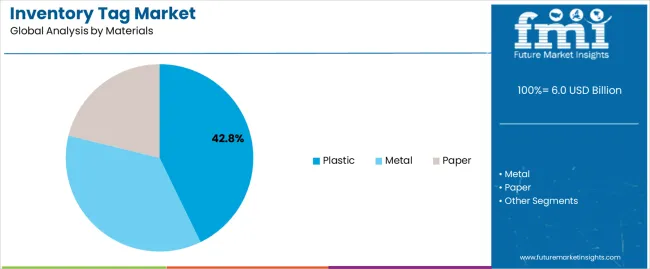
The plastic segment, representing 42.80% of the materials category, has remained the preferred choice due to its durability, flexibility, and resistance to environmental stress. Its dominance is supported by widespread use in retail, logistics, and industrial labeling applications that require long-lasting performance.
Plastic tags are favored for their cost-effectiveness and adaptability to various printing and encoding techniques. Advances in sustainable and recyclable plastics are addressing environmental concerns while maintaining structural integrity.
Lightweight and customizable properties allow these tags to be integrated easily into automated systems and different product categories Continued innovation in biodegradable and heat-resistant plastic materials is expected to strengthen market presence and ensure long-term adoption across diverse end-use industries.
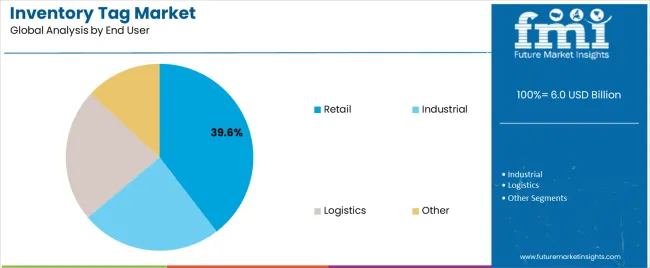
The retail segment, holding 39.60% of the end user category, has emerged as the leading segment due to the sector’s growing focus on inventory accuracy, loss prevention, and customer experience optimization. The use of advanced inventory tagging solutions in retail operations supports faster checkout processes, improved product tracking, and efficient stock replenishment.
Widespread deployment across supermarkets, apparel stores, and e-commerce warehouses has reinforced this segment’s position. Integration of RFID and barcode technologies within retail management systems has enhanced visibility across the supply chain.
Increasing adoption of omnichannel retail strategies is driving the need for seamless inventory synchronization across multiple sales platforms As competition intensifies, retailers are prioritizing smart inventory control, ensuring the segment continues to command a dominant role in the overall market landscape.
| Attributes | Details |
|---|---|
| Top Technology | RFID |
| CAGR (2025 to 2035) | 4.6% |
| Attributes | Details |
|---|---|
| Top Material | Plastic |
| CAGR (2025 to 2035) | 4.4% |
| Countries | CAGR through 2035 |
|---|---|
| United States | 5.0% |
| United Kingdom | 5.5% |
| China | 4.2% |
| Japan | 3.9% |
| South Korea | 3.2% |
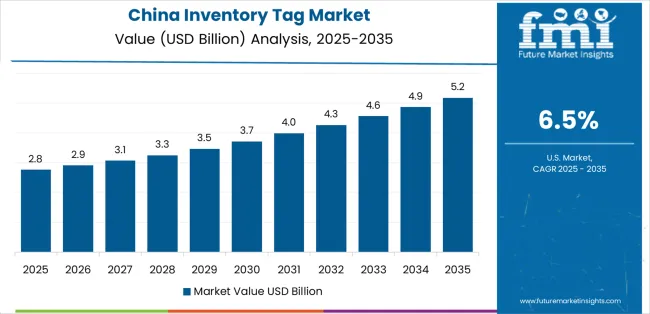
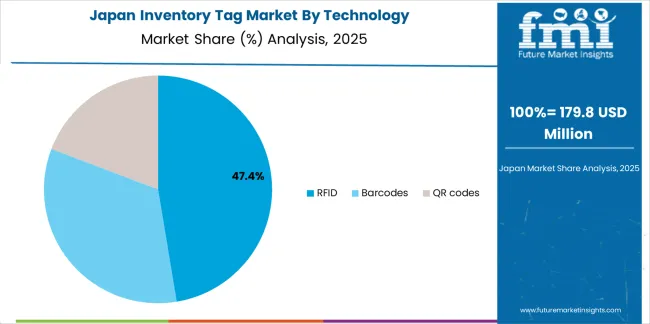
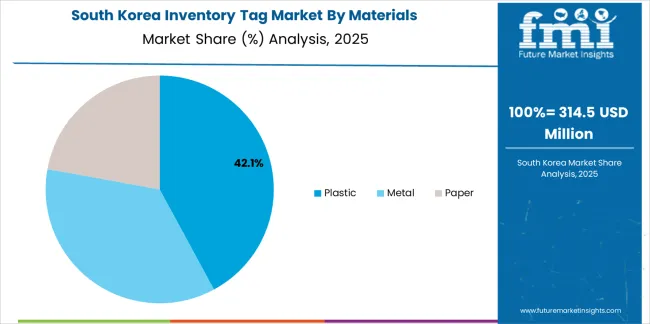
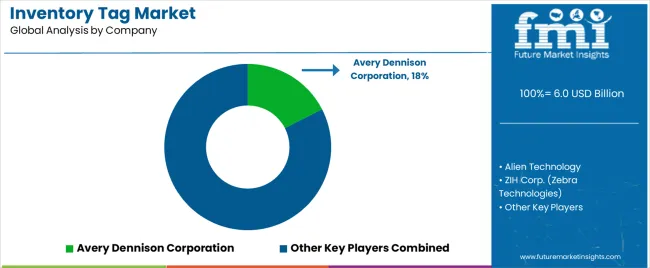
The market is highly competitive with a large number of players offering a wide range of solutions. Some of the key players in the market include well-established players and new entrants.
Key players offer a range of solutions for various industries including retail, healthcare, logistics, and manufacturing. The solutions provided by these players include RFID tags and labels, as well as software solutions for inventory management and asset tracking. The competition in the inventory tag market is driven by factors such as product innovation, pricing, and customer service.
Recent Developments in the Inventory Tag Market
The global inventory tag market is estimated to be valued at USD 6.0 billion in 2025.
The market size for the inventory tag market is projected to reach USD 9.3 billion by 2035.
The inventory tag market is expected to grow at a 4.6% CAGR between 2025 and 2035.
The key product types in inventory tag market are rfid, barcodes and qr codes.
In terms of materials, plastic segment to command 42.8% share in the inventory tag market in 2025.






Our Research Products

The "Full Research Suite" delivers actionable market intel, deep dives on markets or technologies, so clients act faster, cut risk, and unlock growth.

The Leaderboard benchmarks and ranks top vendors, classifying them as Established Leaders, Leading Challengers, or Disruptors & Challengers.

Locates where complements amplify value and substitutes erode it, forecasting net impact by horizon

We deliver granular, decision-grade intel: market sizing, 5-year forecasts, pricing, adoption, usage, revenue, and operational KPIs—plus competitor tracking, regulation, and value chains—across 60 countries broadly.

Spot the shifts before they hit your P&L. We track inflection points, adoption curves, pricing moves, and ecosystem plays to show where demand is heading, why it is changing, and what to do next across high-growth markets and disruptive tech

Real-time reads of user behavior. We track shifting priorities, perceptions of today’s and next-gen services, and provider experience, then pace how fast tech moves from trial to adoption, blending buyer, consumer, and channel inputs with social signals (#WhySwitch, #UX).

Partner with our analyst team to build a custom report designed around your business priorities. From analysing market trends to assessing competitors or crafting bespoke datasets, we tailor insights to your needs.
Supplier Intelligence
Discovery & Profiling
Capacity & Footprint
Performance & Risk
Compliance & Governance
Commercial Readiness
Who Supplies Whom
Scorecards & Shortlists
Playbooks & Docs
Category Intelligence
Definition & Scope
Demand & Use Cases
Cost Drivers
Market Structure
Supply Chain Map
Trade & Policy
Operating Norms
Deliverables
Buyer Intelligence
Account Basics
Spend & Scope
Procurement Model
Vendor Requirements
Terms & Policies
Entry Strategy
Pain Points & Triggers
Outputs
Pricing Analysis
Benchmarks
Trends
Should-Cost
Indexation
Landed Cost
Commercial Terms
Deliverables
Brand Analysis
Positioning & Value Prop
Share & Presence
Customer Evidence
Go-to-Market
Digital & Reputation
Compliance & Trust
KPIs & Gaps
Outputs
Full Research Suite comprises of:
Market outlook & trends analysis
Interviews & case studies
Strategic recommendations
Vendor profiles & capabilities analysis
5-year forecasts
8 regions and 60+ country-level data splits
Market segment data splits
12 months of continuous data updates
DELIVERED AS:
PDF EXCEL ONLINE
Inventory Management Software Market Analysis - Size, Share, and Forecast 2025 to 2035
Tags Market Insights - Growth & Demand 2025 to 2035
Tagatose Market Analysis by Application, Sweetness Profile, Industry Demand, and Regional Forecast from 2025 to 2035
Metagenomics Market Trends - Industry Analysis & Forecast 2025 to 2035
Outage Management System Market Insights – Forecast 2025-2035
Voltage Monitoring Integrated Circuit Market Size and Share Forecast Outlook 2025 to 2035
Voltage Tester Market Size and Share Forecast Outlook 2025 to 2035
Voltage Regulator Market Size and Share Forecast Outlook 2025 to 2035
Voltage Regulator For Advanced Semiconductor Market Size and Share Forecast Outlook 2025 to 2035
Voltage Detector Market Size and Share Forecast Outlook 2025 to 2035
Voltage Transducer Market Size and Share Forecast Outlook 2025 to 2035
Voltage Controlled Oscillators Market Size and Share Forecast Outlook 2025 to 2035
Postage Stamp Paper Market Size, Share & Forecast 2025 to 2035
Global Vintage Packaging Market Growth – Trends & Forecast 2024-2034
Market Share Breakdown of Heritage Tourism Service Providers
Global Heritage Tourism Market Analysis by Experience Type, by End User, and by Region - Forecast for 2025 to 2035
NFC Tag ICs Market Analysis by Memory, Connection, Application, Industry and Region Through 2025 to 2035
Heritage Railway Train Market Analysis – Trends & Forecast 2024-2034
RAIN Tag Antennas Market Size and Share Forecast Outlook 2025 to 2035
Hang Tag Applicators Market Size and Share Forecast Outlook 2025 to 2035

Thank you!
You will receive an email from our Business Development Manager. Please be sure to check your SPAM/JUNK folder too.
Chat With
MaRIA